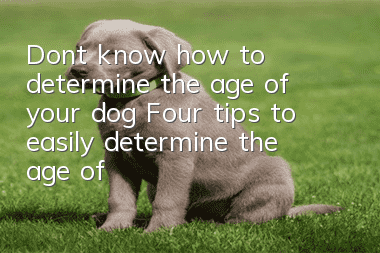Don’t know how to determine the age of your dog? Four tips to easily determine the age of your dog

Look at your dog’s teeth
The wear and tear of your dog’s teeth is related to age. The older you are, the more serious the wear will be. But it should also be noted that this has a lot to do with the nature of the animal's food. For example, if the dog often eats soft food and often chews bones, the dog's tooth wear will be different, so it can only be used as a reference.Look at the dog’s posture
Young dogs are light and nimble when moving. When they are 2-5 years old, their movements are a little clumsy, but they are still stable, safe and reliable. Older dogs over ten years old react slowly, have bent or bent backs, and walk slowly.
Look at the dog’s hair
As the age increases, some dogs with non-gray hair will turn into gray and white hair. The number of symptoms increases significantly when the dog is 5-6 years old, and then spreads to the back, around the nose, eyelids, eyebrows, etc., and then further extends to the forehead and external auditory canal, and even the entire head hair turns white. For dogs with white, yellow and white hair or chestnut hair with white spots, coat color change cannot be used as an auxiliary means to judge age. Look at the dog’s eyes
Young dogs’ eyes are energetic and bright. Cataracts appear in the eyes of dogs over 7 years old. Cataracts occur more frequently in dogs over 8 years old. Dogs aged 9-10 years old have larger eyes. Most dogs have cataracts, and almost all dogs over 10 years old have cataracts. In the early stage of cataract, the lens appears as a blue-green ring, the lens is opaque, gray or off-white, and has obvious green refractive reflection. Random articles
- Is it better for Dogo dogs to have their ears erect or cropped? A case of Dogo dog’s ear erection surgery will tell you
- What do dogs eat to protect their stomach? It is important to protect their stomach and treat gastrointestinal diseases in dogs.
- How to tell if your dog is fat? Is your dog overweight?
- How to train Tibetan Mastiff Four aspects teach you how to train Tibetan Mastiff
- Will your dog catch a cold if you blow the air conditioner? What should you do if your dog catches a cold if you blow the air conditioner?
- What should you pay attention to when your dog drinks water? Don’t be careless when it comes to your dog’s drinking water.
- The dog's mouth bites and shakes. Why does the dog's mouth occasionally shake and bite?
- How to cut a dog's hair? Do you know how to cut a dog's hair correctly?
- Can dogs eat raw eggs? Why can’t dogs eat egg whites?
- Common Dog Problems in Summer How to Deal with Different Dog Problems



